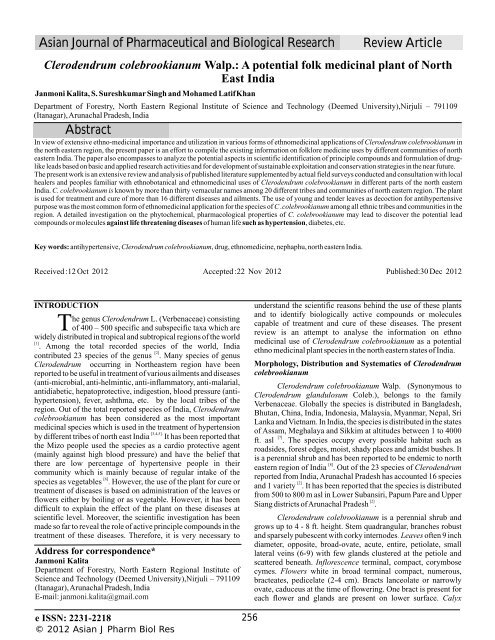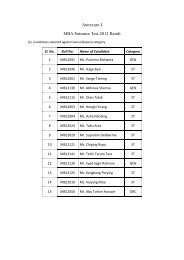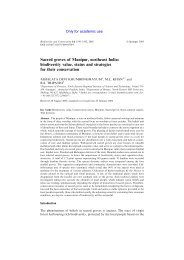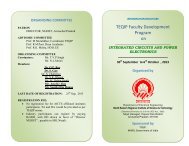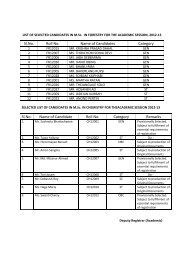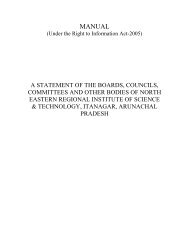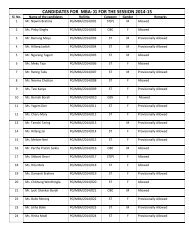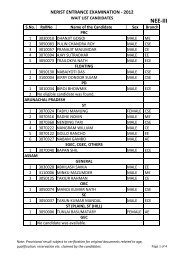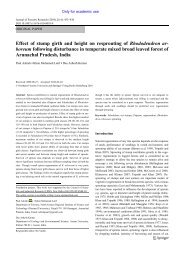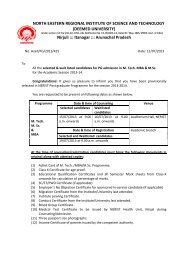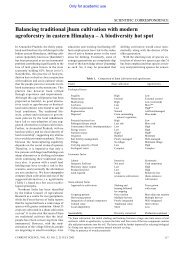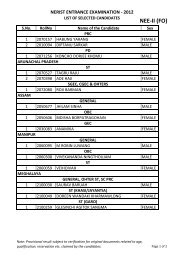Clerodendrum colebrookianum Walp. A potential folk ... - NERIST
Clerodendrum colebrookianum Walp. A potential folk ... - NERIST
Clerodendrum colebrookianum Walp. A potential folk ... - NERIST
You also want an ePaper? Increase the reach of your titles
YUMPU automatically turns print PDFs into web optimized ePapers that Google loves.
Asian Journal of Pharmaceutical and Biological Research<br />
<strong>Clerodendrum</strong> <strong>colebrookianum</strong> <strong>Walp</strong>.: A <strong>potential</strong> <strong>folk</strong> medicinal plant of North<br />
East India<br />
Janmoni Kalita, S. Sureshkumar Singh and Mohamed LatifKhan<br />
Department of Forestry, North Eastern Regional Institute of Science and Technology (Deemed University),Nirjuli – 791109<br />
(Itanagar), Arunachal Pradesh, India<br />
Abstract<br />
Review Article<br />
In view of extensive ethno-medicinal importance and utilization in various forms of ethnomedicinal applications of <strong>Clerodendrum</strong> <strong>colebrookianum</strong> in<br />
the north eastern region, the present paper is an effort to compile the existing information on <strong>folk</strong>lore medicine uses by different communities of north<br />
eastern India. The paper also encompasses to analyze the <strong>potential</strong> aspects in scientific identification of principle compounds and formulation of druglike<br />
leads based on basic and applied research activities and for development of sustainable exploitation and conservation strategies in the near future.<br />
The present work is an extensive review and analysis of published literature supplemented by actual field surveys conducted and consultation with local<br />
healers and peoples familiar with ethnobotanical and ethnomedicinal uses of <strong>Clerodendrum</strong> <strong>colebrookianum</strong> in different parts of the north eastern<br />
India. C. <strong>colebrookianum</strong> is known by more than thirty vernacular names among 20 different tribes and communities of north eastern region. The plant<br />
is used for treatment and cure of more than 16 different diseases and ailments. The use of young and tender leaves as decoction for antihypertensive<br />
purpose was the most common form of ethnomedicinal application for the species of C .<strong>colebrookianum</strong> among all ethnic tribes and communities in the<br />
region. A detailed investigation on the phytochemical, pharmacological properties of C. <strong>colebrookianum</strong> may lead to discover the <strong>potential</strong> lead<br />
compounds or molecules against life threatening diseases of human life such as hypertension, diabetes, etc.<br />
Key words: antihypertensive, <strong>Clerodendrum</strong> <strong>colebrookianum</strong>, drug, ethnomedicine, nephaphu, north eastern India.<br />
Received :12 Oct 2012 Accepted :22 Nov 2012 Published:30 Dec 2012<br />
INTRODUCTION<br />
he genus <strong>Clerodendrum</strong> L. (Verbenaceae) consisting<br />
Tof 400 – 500 specific and subspecific taxa which are<br />
widely distributed in tropical and subtropical regions of the world<br />
[1]<br />
. Among the total recorded species of the world, India<br />
[2]<br />
contributed 23 species of the genus . Many species of genus<br />
<strong>Clerodendrum</strong> occurring in Northeastern region have been<br />
reported to be useful in treatment of various ailments and diseases<br />
(anti-microbial, anti-helmintic, anti-inflammatory, anti-malarial,<br />
antidiabetic, hepatoprotective, indigestion, blood pressure (antihypertension),<br />
fever, ashthma, etc. by the local tribes of the<br />
region. Out of the total reported species of India, <strong>Clerodendrum</strong><br />
<strong>colebrookianum</strong> has been considered as the most important<br />
medicinal species which is used in the treatment of hypertension<br />
[3,4,5].<br />
by different tribes of north east India It has been reported that<br />
the Mizo people used the species as a cardio protective agent<br />
(mainly against high blood pressure) and have the belief that<br />
there are low percentage of hypertensive people in their<br />
community which is mainly because of regular intake of the<br />
[6]<br />
species as vegetables . However, the use of the plant for cure or<br />
treatment of diseases is based on administration of the leaves or<br />
flowers either by boiling or as vegetable. However, it has been<br />
difficult to explain the effect of the plant on these diseases at<br />
scientific level. Moreover, the scientific investigation has been<br />
made so far to reveal the role of active principle compounds in the<br />
treatment of these diseases. Therefore, it is very necessary to<br />
Address for correspondence*<br />
Janmoni Kalita<br />
Department of Forestry, North Eastern Regional Institute of<br />
Science and Technology (Deemed University),Nirjuli – 791109<br />
(Itanagar), Arunachal Pradesh, India<br />
E-mail: janmoni.kalita@gmail.com<br />
e ISSN: 2231-2218<br />
© 2012 Asian J Pharm Biol Res<br />
256<br />
understand the scientific reasons behind the use of these plants<br />
and to identify biologically active compounds or molecules<br />
capable of treatment and cure of these diseases. The present<br />
review is an attempt to analyse the information on ethno<br />
medicinal use of <strong>Clerodendrum</strong> <strong>colebrookianum</strong> as a <strong>potential</strong><br />
ethno medicinal plant species in the north eastern states of India.<br />
Morphology, Distribution and Systematics of <strong>Clerodendrum</strong><br />
<strong>colebrookianum</strong><br />
<strong>Clerodendrum</strong> <strong>colebrookianum</strong> <strong>Walp</strong>. (Synonymous to<br />
<strong>Clerodendrum</strong> glandulosum Coleb.), belongs to the family<br />
Verbenaceae. Globally the species is distributed in Bangladesh,<br />
Bhutan, China, India, Indonesia, Malaysia, Myanmar, Nepal, Sri<br />
Lanka and Vietnam . In India, the species is distributed in the states<br />
of Assam, Meghalaya and Sikkim at altitudes between 1 to 4000<br />
[7]<br />
ft . asl . The species occupy every possible habitat such as<br />
roadsides, forest edges, moist, shady places and amidst bushes. It<br />
is a perennial shrub and has been reported to be endemic to north<br />
[8]<br />
eastern region of India . Out of the 23 species of <strong>Clerodendrum</strong><br />
reported from India, Arunachal Pradesh has accounted 16 species<br />
[2]<br />
and 1 variety . It has been reported that the species is distributed<br />
from 500 to 800 m asl in Lower Subansiri, Papum Pare and Upper<br />
[2]<br />
Siang districts of Arunachal Pradesh .<br />
<strong>Clerodendrum</strong> <strong>colebrookianum</strong> is a perennial shrub and<br />
grows up to 4 - 8 ft. height. Stem quadrangular, branches robust<br />
and sparsely pubescent with corky internodes.<br />
Leaves often 9 inch<br />
diameter, opposite, broad-ovate, acute, entire, petiolate, small<br />
lateral veins (6-9) with few glands clustered at the petiole and<br />
scattered beneath. Inflorescence terminal, compact, corymbose<br />
cymes. Flowers white in broad terminal compact, numerous,<br />
bracteates, pedicelate (2-4 cm). Bracts lanceolate or narrowly<br />
ovate, caduceus at the time of flowering. One bract is present for<br />
each flower and glands are present on lower surface. Calyx
Table 1: Systematic position of <strong>Clerodendrum</strong><br />
<strong>colebrookianum</strong> <strong>Walp</strong>.<br />
Taxonomy Hierarchy<br />
Phylum<br />
Class<br />
Order<br />
Family<br />
Name<br />
Magnoliophyta<br />
Magnoliopsida<br />
Lamiales<br />
Verbenaceae<br />
Genus <strong>Clerodendrum</strong> L.<br />
Species <strong>Clerodendrum</strong> <strong>colebrookianum</strong> <strong>Walp</strong>.<br />
Table 2: Vernacular names of <strong>Clerodendrum</strong> <strong>colebrookianum</strong> in north eastern states of India.<br />
Asian J Pharm Biol Res |Oct-Dec 2012 | Vol-2 | Issue-4<br />
gamosepalous, persistent, sepaloid, campanulate with several<br />
peltate glands, sepals 5 and glandular. Calyx-teeth short<br />
triangular, reddish purple. Corolla gamopetalous, petals 5, white<br />
in colour, tube nearly glabrous, stamens 4, didynamous, filiform.<br />
Gynoecium has exerted style and shorter than stamen with 4<br />
loculi. Anthers reddish or marron, introse. Fruit is drupe,<br />
subglobose, glossy and bluish green in colour that turns on black<br />
[7]<br />
on drying . <strong>Clerodendrum</strong> <strong>colebrookianum</strong> is distinguished by<br />
having broadly ovate or cordate leaf blade with large peltate<br />
glands or glands on the abaxial surface of the leaf base and<br />
corymb thrysoid inflorescence (Figure 1a). The taxonomical<br />
State<br />
Arunachal Pradesh<br />
Assam<br />
Nagaland<br />
Mizoram<br />
Meghalaya<br />
Manipur<br />
Vernacular Names<br />
Tapen (Adi); Papua-toh (Bangni); Poto (Nishi); Potto ooh (Hill Miri); Doloin/Jylon (Aka); Dringi<br />
(Zeme- Naga); Papa tsitsu (Memba); Nephaphu (Nocte/Singpho/Khampti/Tangsa); Ongin (Adi,<br />
Apatani); Pherkhom (Mikir); Unpui (Kuki); Khangjela-shing (Monpa); Ganmakhei (Kilya-Naga),<br />
Huikam (Marring); Arum (Lotha -Naga, Konyak -Naga); Yananing (Sema-Naga).<br />
Nephaphu (Assmese/ Bodo Kachari/Tiwa/Miri), Naga sag (Tea tribes); Sgainyaopalai, Mismao<br />
(Dimasa Kachari); Anphui (Hmar); Mishimau (Barman); Puihnam (Lushai)<br />
Orematong, Umrem (Naga)<br />
Phuinum (Mizo)<br />
Jarem, Sia-long (Khasi); Dien-ja-rem-kyntheri, Jhr-khtung (Jaintia); Yay-iong (Garo)<br />
Kuthab, Kutab-manbi (Manipuri)<br />
Table 3. Uses of <strong>Clerodendrum</strong> <strong>colebrookianum</strong> against hypertension by various tribes of North East India.<br />
State Tribe Plant parts Mode of administration References<br />
Arunachal Tangsa Leaves, twig Boiled in water and mixed with a few Nath and Bodoloi 1993<br />
Pradesh<br />
ground pieces of Allium sativum L. (Lasun /<br />
Tangsa) and salt, are prescribed orally as<br />
soup or decoction for a consecutive period<br />
of three months, twice a day, on alternate<br />
days at 200 g per dose<br />
Bangnis Leaves Decoction or juice given orally Gupta 2000<br />
Nishi Leaves Decoction (3-4 tea spoonful) twice daily Bhuyan 2003<br />
Apatani Leaves Boiled or infusion is taken orally Khongsai et al. 2011,<br />
Kala 2005<br />
Hill Miri Leaves Juice Tag and Das 2004<br />
Memba Leaves Decoction Rethy et al. 2010<br />
Adi Leaves Decoction taken 3-4 tea spoonful twice<br />
daily<br />
Srivastava and<br />
Choudhary 2008,<br />
Srivastava and Adi<br />
community 2009<br />
Monpa Leaves Decoction with sugar Namsa et al. 2011<br />
Assam Hmar Leaves Leaf juice are eaten after heating Nath and Choudhury<br />
2010<br />
Jaintia, Lushai Leaves Taken as raw Sajem and Gosai 2006,<br />
2010<br />
Moran Leaves Decoction Buragohain 2011<br />
Dimasa Kachari Leaves Leaf extract Tamuli and Sharma<br />
2010<br />
Zeme Leaves Soup Tamuli and Saikia 2004<br />
Mishing Young twig Boiled Gogoi et al. 2010<br />
Assamese Leaves Boiled and extract Gogoi et al. 2003<br />
257
Asian J Pharm Biol Res |Oct-Dec 2012 | Vol-2 | Issue-4<br />
Table 4: Uses of <strong>Clerodendrum</strong> <strong>colebrookianum</strong> against various ailments by different tribes of North East India.<br />
Disease State Tribe Plant parts Mode of administration References<br />
Abdominal pain Assam Tai-Ahom Leaves Three teaspoonful leaf extract<br />
is mixed with small amount of<br />
Kalita and Phukan<br />
2010<br />
common salt and is taken<br />
thrice daily<br />
Anthelmintic Assam Assamese Leaves - Jain and Saklani<br />
Antidote Nagaland Naga Leaves Infusion of leaves mixed with<br />
bark paste of the “menpan<br />
plant” is drunk<br />
1992<br />
Changkija 1999<br />
Blood purifier Assam Lushai Leaves - Sajem and Gosai<br />
2010<br />
Colics in infants Mizoram Mizo Leaves Juice of 5 ml twice daily Sharma et al. 2001<br />
Cough<br />
Arunachal<br />
Pradesh<br />
Adi, Nishi Leaves - Jain and Saklani<br />
1992<br />
Diabetes Assam Jaintia Leaves Taken raw Sajem and Gosai<br />
2006<br />
Barman<br />
community<br />
Leaves Decoction Das and Sharma<br />
2003<br />
Zeme Leaves Decoction Tamuli and Saikia<br />
2004<br />
Mizoram Mizo Leaves Decoction Sharma et al. 2001<br />
Diarrhoea and<br />
dysentery<br />
Gastric disorders<br />
Arunachal<br />
Pradesh<br />
Arunachal<br />
Pradesh<br />
Adi, Nishi Leaves Juice Jain and Saklani<br />
1992<br />
Dimasa<br />
Kachari<br />
Root Extract Tamuli and<br />
Sharma 2010<br />
Bangni Leaf, tender Decoction or juice Gupta 2006<br />
stem<br />
a<br />
a<br />
b<br />
c<br />
d<br />
e<br />
Figure 1: (a) <strong>Clerodendrum</strong> <strong>colebrookianum</strong> in its natural habitat, (b) flowering, (c) terminal panicle inflorescence with white<br />
flowers, (d) matured fruits and (e) seedling<br />
258
Asian J Pharm Biol Res |Oct-Dec 2012 | Vol-2 | Issue-4<br />
25<br />
20<br />
Number of tribes<br />
15<br />
10<br />
5<br />
0<br />
Abdominal pain<br />
Anthelmintic<br />
Antidote<br />
Blood purifier<br />
Colics in infants<br />
Cough<br />
Diabetes<br />
Diarrhoea and dysentery<br />
Fever<br />
Gastric disorders<br />
Headache<br />
Heart trouble<br />
Heart trouble<br />
Hypertension<br />
Malarial fever<br />
Reduce weight<br />
Rheumatism<br />
Stomachache<br />
Ailments<br />
Figure 2: <strong>Clerodendrum</strong> <strong>colebrookianum</strong> used in various ailments by different tribes of North East India.<br />
β-sitosterol Colebrin A Colebrin B<br />
Colebrin D<br />
Colebrin E<br />
Figure 3: Structures of isolated compounds from <strong>Clerodendrum</strong> <strong>colebrookianum</strong> (Source: Shrivastava and Patel, 2007b).<br />
hierarchy of C. <strong>colebrookianum</strong> is presented in Table 1.<br />
Ethno Botany And Ethno Medicine Of The Genus<br />
<strong>Clerodendrum</strong><br />
Available published literatures on ethno botany and ethno<br />
medicine of the genus <strong>Clerodendrum</strong>, especially on<br />
<strong>Clerodendrum</strong> <strong>colebrookianum</strong> in north eastern region of India<br />
since last twenty years were consulted for the present review. A<br />
review of literatures pertaining to biological activities of the plant<br />
species was also conducted to verify the validity of the <strong>folk</strong>lore<br />
claims. This study covered tribal communities such as Adi,<br />
Apatani, Bodos, Chakmas, Deories, Dimasas, Garos, Khasis,<br />
Kukies, Mishing, Nishi, Nocte, Shyams and Syngphos,<br />
Sonowals, Tai-Ahoms and Tai-Khamtis residing in six north<br />
eastern states in north eastern states of India.<br />
Extensive field surveys were carried out in different areas<br />
of the state during 2010-2011. Different medicinal uses and<br />
utilization patterns of <strong>Clerodendrum</strong> <strong>colebrookianum</strong> were<br />
collected with the structured interviewed with the local<br />
inhabitants and cross check was done (Appendix A). Specimen<br />
were collected and identified by consulting the research paper and<br />
[2,7]<br />
available flora references and Herbaria at Botanical Survey of<br />
259
Asian J Pharm Biol Res |Oct-Dec 2012 | Vol-2 | Issue-4<br />
India (BSI) Itanagar, Arunachal Pradesh were also consulted for<br />
validation of identifications. The specimens are deposited in the<br />
Herbarium of Forestry Department, <strong>NERIST</strong>, Arunachal Pradesh<br />
for further research work.<br />
It has been found that the species is known by 33 different<br />
vernacular names by the 35 tribal communities of north eastern<br />
region of India (Table 2). The species is widely used by 20<br />
different tribes of six states of North East India for the treatment<br />
of hypertension (Table 3). Of the plant parts, leaf was used in<br />
majority of cases. In addition to hypertension, the species have<br />
also been used against other ailments like diabetes, blood<br />
purification, abdominal pain, diarrhoea, dysentery, heart trouble,<br />
cough etc. (Table 4). However, majority of tribal communities of<br />
north eastern states used the species against hypertension (Figure<br />
2). Preparations were found to be used in the form of decoction,<br />
juice, leaf extract, raw, soup, boiled, infusion etc. The present<br />
study also reveals that use of the plant as a home remedy for the<br />
treatment of hypertension is not confined to a particular group of<br />
ethnic tribe or a particular community but it is widely used by a<br />
large number of tribal communities belonging to different states<br />
of north eastern region of India.<br />
The chemical constituent of C. <strong>colebrookianum</strong> shows<br />
the presence of phenols, alkaloids, flavonoids, polyphenols,<br />
[1]<br />
steroids etc. . Furthermore, GC MS analysis of C.<br />
<strong>colebrookianum</strong> hexane extract shows the presence of 28<br />
[8]<br />
compounds . Five new steroids, colebrin A-E were also isolated<br />
[9]<br />
from the aerial parts of the species . Moreover, presence of β-<br />
sitosterol and sterol compounds in the leaves of C.<br />
[10, 11]<br />
<strong>colebrookianum</strong> has already been reported (Figure 3). β-<br />
sitosterol, a bioactive phytoconstituent that decrease the serum<br />
cholesterol and also have cardio protective <strong>potential</strong>ity which is<br />
a valid scientific basis for consuming it for better health in north<br />
[12]<br />
east region of India . Earlier it had been indicated a beta<br />
blocking effect on toads and dogs and a gradual fall of blood<br />
[5]<br />
pressure within humans . Antihypertensive property of C.<br />
<strong>colebrookianum</strong> has been reported from the leaf extract of the<br />
[13]<br />
species . It has been reported that C. <strong>colebrookianum</strong> extract<br />
has role in ameliorating experimentally induced insulin<br />
resistance and hypertension and provides the first<br />
pharmacological evidence for protective role of C.<br />
<strong>colebrookianum</strong> leaf against experimentally induced metabolic<br />
[8]<br />
syndrome .<br />
The pharmacological study of C. <strong>colebrookianum</strong><br />
indicates the immense <strong>potential</strong> for the treatment of diabetes and<br />
hypertension. But still, the full <strong>potential</strong> of C. <strong>colebrookianum</strong><br />
has not been explored. Most of the research has been in vivo and<br />
helped validate the applicability on the human system. In vitro<br />
studies could have facilitated a better understanding the mode of<br />
action of C. <strong>colebrookianum</strong>.<br />
The current research also shows leaves are used<br />
extensively for medicinal purposes. Moreover, there has not been<br />
any report regarding cultivation of the species by the local<br />
people. This is one of the major concerns for the sustainable<br />
utilization and conservation because of over harvesting from the<br />
wild which may lead to depletion of the population or extinction<br />
of the species particularly from its habitat. In addition,<br />
anthropogenic disturbances may lead the degradation of the<br />
species from natural habitats. Thus, there is an urgent need for<br />
exploration, documentation, identification and prioritization of<br />
important medicinal plant species.<br />
CONCLUSION<br />
The information from the present study needs thorough<br />
phytochemical investigation along with clinical trials. In Silico<br />
screening of the biochemical compounds and metabolites may<br />
lead to finding or predicting <strong>potential</strong> drug candidates against life<br />
threatening diseases and other bioactive compounds of other uses.<br />
Development of database, proper harvesting and cultivation<br />
techniques and also awareness programs in the state as well as<br />
region level for the conservation and management of <strong>potential</strong><br />
species are utmost important.<br />
ACKNOWLEDGMENT<br />
The authors are grateful Dr. A. A. Mao, Joint Director,<br />
Botanical Survey of India, Arunachal Pradesh for identification of<br />
<strong>Clerodendrum</strong> species. The authors thank local guides and<br />
villagers for cooperation and support during the field work.<br />
REFERENCES<br />
1. Shrivastava N, Patel T: <strong>Clerodendrum</strong> and Healthcare: An<br />
overview. Medicinal Aromatic Plant Sci. Biotech., 2007a,<br />
1(1): 142-150.<br />
2. Srivastava RC, Choudhary RK: Species diversity and<br />
Economic importance of the family Verbenaceae in<br />
Arunachal Pradesh. Bull. Arun. Prad. Res., 2008, 24(1&2):<br />
1-21.<br />
3. Bhuyan LR: Some plants used as medicines by the Nishi<br />
tribe of Arunachal Pradesh: A preliminary study. J. Econ.<br />
Taxon. Bot. 2003, 27(2): 447-450.<br />
4. Buragohain J: Ethnomedicinal Plants Used by the ethnic<br />
Communities of Tinsukia District of Assam, India. Recent<br />
Res. Sci. Tech., 2011, 3(9): 31-42.<br />
5. Nath SC, Bordoloi DN: <strong>Clerodendrum</strong> <strong>colebrookianum</strong>, a<br />
Folk Remedy for the Treatment of Hypertension in<br />
Northeastern India. Pharmaceu. Biol., 1991, 29(2): 127-<br />
129.<br />
6. Bordoloi B, Borthakur SK: Botanical identity of “Phuinum”<br />
a <strong>folk</strong> remedy for hypertension. Bull med-ethno. Bot. Res.,<br />
CCRAS, New Delhi, 1997, 18(1/2): 18-29.<br />
7. Hooker JD: Flora of British India. L. Reeve and Co. Ltd,<br />
Kent. 1885, IV: 589-596.<br />
8. Jadeja RN, Thounaojam MC, Ramani UV, Devkar RV,<br />
Ramachandran A: Anti-obesity <strong>potential</strong> of Clerodendron<br />
glandulosum Coleb. leaf aqueous extract. J.<br />
Ethnopharmacol., 2011, 135(2): 338-343.<br />
9. Yang H, Wang J, Hou AJ, Gou YP, Lin ZW, Sun HD: New<br />
steroids from <strong>Clerodendrum</strong> <strong>colebrookianum</strong>. Fitoterapia,<br />
2000, 71(6): 641-648.<br />
10. Jacke G, Rimpler H: Distribution of iridoid glycosides in<br />
<strong>Clerodendrum</strong> species. Phytochemistry, 1983, 22(8): 1729-<br />
1734.<br />
11. Goswami P, Kotoky J, Chern Z, Lu Y: A sterol glycoside from<br />
leaves of Clerodendron <strong>colebrookianum</strong>. Phytochemistry,<br />
1995, 41(1): 279-281.<br />
12. Devi R, Sharma DK: Hypolipidemic effect of different<br />
extracts of Clerodendron <strong>colebrookianum</strong> <strong>Walp</strong>. in normal<br />
and high-fat diet fed rats. J. Ethnopharmacol., 2004, 90(1):<br />
63-68.<br />
260
Asian J Pharm Biol Res |Oct-Dec 2012 | Vol-2 | Issue-4<br />
13. Purkayastha J, Nath SC. Biological activities of<br />
ethnomedicinal claims of some plant species of Assam.<br />
Indian J. Tradit. Know., 2006, 5(2): 230-236.<br />
14. Nath SC, Bordoloi DN: Diversity of Economic Flora in<br />
Arunachal Pradesh: Plant <strong>folk</strong> medicines among the<br />
Chakma, Singpho and Tangsa tribals. In Himalayan<br />
Biodiversity Conservation Strategies. Edited by Dhar, U. G.<br />
B. Pant Institute of Himalayan Environment &<br />
Development, Almora; 1993: 179-189.<br />
15. Gupta V: Traditional medicinal plants of the Bangnis of East<br />
Kameng district, Arunachal Pradesh. J. Econ. Taxon. Bot.,<br />
2006, 30(Suppl.): 310-319.<br />
16. Khongsai M, Saikia M, Saikia SP, Kayang H:<br />
Ethnomedicinal plants used by different tribes of Arunachal<br />
Pradesh. Indian J. Tradit. Know., 2011, 10(3): 541-546.<br />
17. Kala CP: Ethnomedicinal botany of the Apatani in the<br />
Eastern Himalayan region of India, J. Ethnobiol.<br />
Ethnomed., 2005, 16: 1-11.<br />
18. Tag H, Das AK: Ethnobotanical notes on Hill Miri tribe of<br />
Arunachal Pradesh. Indian J. Tradit. Know., 2004, 3(1): 80-<br />
85.<br />
19. Rethy P, Singh B, Kagyung R, Gajurel PR: Ethnobotanical<br />
studies of Dehang Debang Biosphere Reserve of Arunachal<br />
Pradesh with reference to Memba tribe. Indian J. Tradit.<br />
Know., 2010, 9(1): 61-67.<br />
20. Srivastava RC, Adi community: Traditional knowledge of<br />
Adi tribe of Arunachal Pradesh on plants. Indian J. Tradit.<br />
Know., 2009, 8(2): 146-153.<br />
21. Namsa ND, Mandal M, Tangjang S, Mandal SC.<br />
Ethnobotany of the Monpa ethnic group at Arunachal<br />
Pradesh, India. J. Ethnobio. Ethnomed., 2011, 7: 31.<br />
22. Nath M, Choudhury MD: Ethno-medico-botanical aspects<br />
of Hmar tribe of Cachar district, Assam (Part-I). Indian J.<br />
Tradit. Know., 2010, 9(4): 760-764.<br />
23. Sajem AL, Gosai K: Traditional use of medicinal plants by<br />
the Jaintia tribes in North Cachar Hills district of Assam,<br />
northeast India. J. Ethnobio. Ethnomed., 2006, 2: 33.<br />
24. Sajem AL, Gosai K: Ethnobotanical investigations among<br />
the Lushai tribes of North Cachar Hills district of Assam,<br />
Northeast India. Indian J. Tradit. Know., 2010, 9(1): 108-<br />
113.<br />
25. Tamuli P, Sharma P: Ethno-medico-botany of the Dimasa<br />
Kachari of North Cachar Hills district of Assam. Indian J.<br />
Tradit. Know., 2010, 9(4): 718-720.<br />
26. Tamuli P, Saikia R: Ethno-medico-botany of the Zeme tribe<br />
of North Cachar Hills district of Assam. Indian J. Tradit.<br />
Know., 2004, 3(4): 430-436.<br />
27. Gogoi M, Upadhyaya S, Borkataky M, Kardong D, Saikia<br />
LR, Samanta R: Use of Indigenous plants in traditiona<br />
health care systems by Mishing tribe of Upper Assam.<br />
SIBCOLTEJO 2010, 5: 92-101.<br />
28. Gogoi R, Bokolial D, Hazarika D: Preliminary observation<br />
on the medicinal plants of Chandrapur area of Kamrup<br />
district, Assam. J. Econ. Taxon. Bot., 2003, 27(2): 410-415.<br />
29. Das AK, Sharma GD: Ethnomedicinal uses of plants by<br />
Manipuri and Barman communities of Cachar district,<br />
Assam. J. Econ. Taxon. Bot., 2003, 27(2): 421-429.<br />
30. Das AK, Dutta BK, Sharma GD: Medicinal plants used by<br />
different tribes of Cachar district, Assam. Indian J. Tradit.<br />
Know., 2008, 7(3): 446-454.<br />
31. Changkija S: Folk Medicinal Plants of the Nagas in India.<br />
Asian Folk. Stud., 1999, 58(1): 205-230.<br />
32. Jamir TT, Sharma HK, Dolui AK: Folklore medicinal plants<br />
of Nagaland, India. Fitoterapia, 1999, 70(1): 395-401.<br />
33.<br />
Sharma HK, Chhangte L, Dolui AK: Traditional medicinal<br />
plants in Mizoram, India. Fitoterapia, 2001, 72(2): 146-<br />
161.<br />
34. Hynniewta SR, Kumar Y: Herbal remedies among the Khasi<br />
traditional healers and village <strong>folk</strong>s in Meghalaya. Indian J.<br />
Tradit. Know., 2008, 7(4): 581-586.<br />
35. Chhetri RB: Trends in ethnodomestication of some wild<br />
plants in Meghalaya, Northeast India. Indian J. Tradit.<br />
Know., 2006, 5(3): 342-347.<br />
36. Deb L, Singh Kh R, Singh BK, Thongam B: Some ethnomedicinal<br />
plants used by the native practitioners of Chandel<br />
District, Manipur, India. Int. Res. J. Pharmacy, 2011, 2(12):<br />
199-200.<br />
37. Pfoze NL, Kumar Y, Myrboh B: Survey and assessment of<br />
ethnomedicinal plants used in Senapati District of<br />
Manipur State, Northeast India. Phytopharmacology,<br />
2012, 2(2): 285-311.<br />
38. Kalita D, Phukan B: Some ethnomedicines used by the Tai<br />
Ahom of Dibrugarh district, Assam, India. Indian J. Nat.<br />
Prod. Res., 2010, 1(4): 507-511.<br />
39. Jain SK, Saklani A: Cross-cultural ethnobotanical studies in<br />
northeast India. Ethnobotany, 1992, 4: 25-38.<br />
40. Singh SP, Tripathi S, Shukla RS: Ethnomedicinal heritage<br />
for bioprospecting and drug development in Northeastern<br />
states of India. J. Econ. Taxon. Bot., 2003, 27(2): 384-395.<br />
41. Shrivastava N, Patel T: <strong>Clerodendrum</strong> and Healthcare: An<br />
overview- Part II. Phytochemistry and Biotechnology.<br />
Medicinal Aromatic Plant Sci. Biotech., 2007b. 1(2): 209-<br />
223.<br />
261


